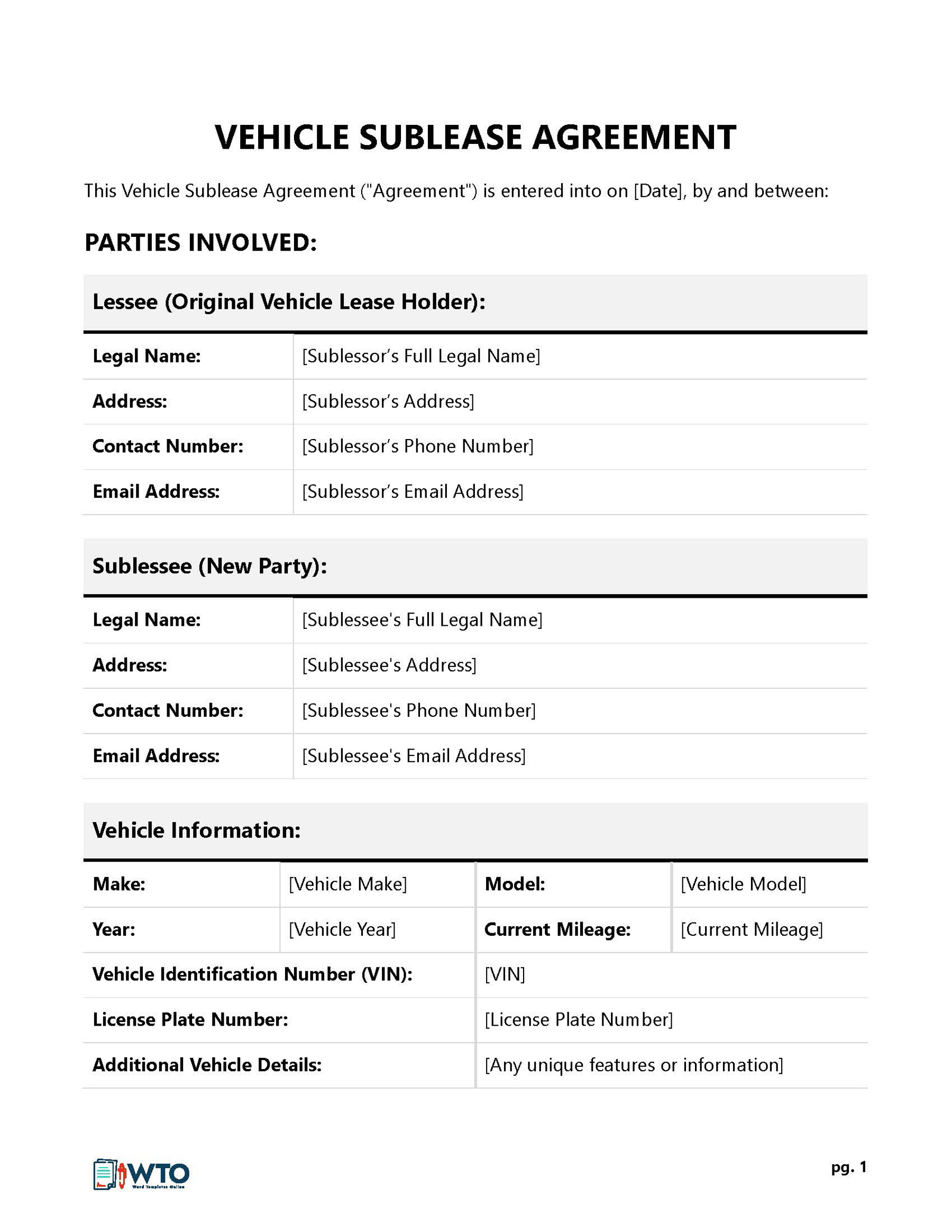Subleasing is an established practice in the vehicle leasing industry. It is a situation where the original lessee, who has leased a vehicle from a leasing company or owner, decides to sublease the vehicle to another individual, the sublessee. The decision may be driven by various reasons, such as a desire to share the lease costs. A template for a vehicle sublease agreement can be used to document this arrangement. A well-drafted and carefully executed agreement helps protect the interests of both parties by providing clarity and a legal framework for the subleasing arrangement. The agreement protects both parties from potential legal and financial consequences.
This article is written to educate you on the benefit of using a template to document a vehicle sublease agreement between you and a sublessee. It will look into the essential components of this guide and the steps of drafting it. Also, it discusses tips on how to make it more beneficial in crafting a legally protective agreement. You can use our free templates to craft effective agreements that are consistently well-organized for subleasing your vehicle for multiple sublessees.
Free Vehicle Sublease Agreement Template

What is a Vehicle Sublease Agreement Template?
A vehicle sublease agreement template is a standardized document that offers a customizable framework and outlines the terms & conditions of a legally binding arrangement for subleasing a vehicle.
It allows you, as the original lessee, to act as the primary vehicle owner. Moreover, it allows you to permit another party (the sublessee) to use the leased vehicle for a specified period within the original lease term.
This agreement typically includes sections for identifying the involved parties’ rights and responsibilities. Information in these sections forms the entire agreement, thus ensuring you and the sublessee are on the same page regarding each party’s expectations. The template is thus not a mere formality but a crucial tool for establishing a clear and comprehensive framework for documenting the subleasing relationship. However, you can customize its sections to suit the specific sublease needs.
The template streamlines the process of creating a legally binding sublease contract. It can thus be presented in court as evidence of the arrangement when disputes or breaches arise. Consequently, this quality provides you with legal protection and assurance that both parties will fulfill their contractual obligations.
Components of a Vehicle Sublease Agreement Template
A template will outline the structure of a typical vehicle sublease agreement. This organization of sections is meant to guide you on what information you must input in each placeholder. While it provides a universal format, it can be modified to incorporate or remove sections per your specific situation.
A standard template will have the following components:
Parties involved
This section identifies the individuals or entities entering into the sublease agreement – you and the sublessee. It constitutes legal names, addresses, and contact information. Clear identification of the parties facilitates communication and ensures legal accountability.
Vehicle information
The vehicle must be clearly identified in this section by providing detailed information about the vehicle being subleased, including the make, model, year, license plate number, VIN (vehicle identification number), and current mileage. This section helps avoid confusion about the specific vehicle being subleased.
Condition of vehicle
Use this section to describe the vehicle’s condition at the beginning of the sublease. This component will highlight any existing damages, modifications, or regular wear and tear on the vehicle. This information serves as a reference point to determine who is responsible for paying for pre-existing damages or wear and tear.
Duration of sublease
This section specifies the start and end dates of the sublease agreement. It also outlines any options for renewal or extension, if applicable. However, note that the sublease period should not exceed the original lease term. Clarify that the timeline is crucial to both parties so that any necessary work can be completed on time before your original lease expires.
Rent and payment terms
Clarifying the rent and payments ensures that you communicate your financial expectations within the sublease arrangement. So, this template component outlines the monthly rental amount, frequency of payments, due date, and payment method. It may also detail any late fees or penalties you will charge the sublessee for missed payments.
Security deposit
This component addresses whether you will require a security deposit from the sublessee, its amount, and the conditions under which it will be returned or forfeited. A security deposit protects you from potential damages or non-payment by the sublessee.
Use of vehicle
In this section, you should specify how the sublessee can use the vehicle. This includes any restrictions or prohibited activities (e.g., commercial use, off-road use, modifications) that may require prior consent. It helps protect the condition of the vehicle during the sublease.
Insurance requirements
You and the sublessee may require insurance coverage to complete the transaction properly. If this is the case, this component should document the insurance coverage required for the subleased vehicle, liability insurance, and comprehensive/collision coverage. Also, it should outline how insurance claims will be handled after accidents or damages.
Maintenance and repairs
This component indicates who is responsible for vehicle maintenance, repairs, and servicing during the sublease period. It can also specify how major repairs are handled and if paperwork has to be retained.
Mileage limits
Use this component to indicate any mileage limits or guidelines for the sublessee. Exceeding mileage limits may result in additional fees, so it is crucial to define these limits clearly. Also, clarify how mileage will be tracked.
Sublease termination
This section will let you specify the conditions under which either party can terminate the sublease agreement. This could include default, violation of terms, or mutual agreement by both parties. This section also indicates the notice requirements for termination.
Return of vehicle
This section outlines the process for returning the vehicle at the end of the sublease, including any fees/penalties for excess wear and mileage. It ensures that this last step is completed seamlessly without hindrances.
Indemnification and liability
It is vital to define how liability and reimbursement for vehicle damages should be handled during and after the sublease. So, use this section to explain who is responsible for damages, accidents, or legal issues that may arise during the sublease period. This prevents disputes that can escalate to litigations.
Default and remedies
This section will let you describe what constitutes a default under the sublease agreement and the remedies available to both parties in case of a breach. This section helps protect the interests of both parties in case of non-compliance.
Governing law
The governing law section specifies the jurisdiction or state laws that will govern the sublease agreement. This ensures that the agreement is executed in compliance with local laws and regulations. Any issues that arise should be resolved within the stated jurisdiction.
Additional terms and conditions
In this part of the template, there is space for any additional terms or conditions that either you or the sublessee wish to include in the sublease agreement. Examples of restrictions include no smoking in the vehicle or passenger limits.
Signatures
The agreement requires signatures from both you (the original lessee) and the sublessee to indicate their acceptance of the terms and conditions. To achieve this, the template has sections for signatures to make the agreement legally binding.
Witness and notary
The agreement may include provisions for witnesses and notarization depending on applicable legal requirements and preferences. These features further authenticate the document’s legality and validity, adding an extra layer of protection for both parties. The template will thus have sections to input this information.
Step-by-Step Guide for Drafting a Vehicle Sublease Agreement
A sublease agreement should document all the information needed to record the arrangement between you and the sublease and the details of the vehicle involved. This document is crafted after you have reached a decision.
Here are the particular steps you can follow to create a thorough and legally binding agreement to sublease your leased vehicle:
Step 1: Gather the information
Begin by collecting all the necessary information, such as details about the sublessee – their or business name, address, and contact details. Also, collect the vehicle information (make, model, year, VIN, mileage, etc.). Then, discuss the specifics of the sublease terms (duration, rent, security deposit, insurance requirements, etc.) and other conditions applicable. Additionally, have supporting documents like an inspection report or the original lease agreement.
Step 2: Choose a template
Select a template that suits your subleasing needs. You can find such guides online or through legal services software. Ensure the chosen one includes all the necessary sections, such as parties involved, payment terms, insurance requirements, and termination conditions. Also, ensure it can be customized to suit your unique requirements and comply with local laws and regulations.
Step 3: Draft the agreement
Using the chosen template, fill in the relevant information collected in Step 1 and customize the agreement to reflect your specific sublease arrangement. Be thorough and ensure important clauses are included. These include addressing aspects such as payment terms, security deposit, servicing and repair obligations, insurance needs, termination, notice requirements, and prohibited activities. Ensure that the language used is precise and easily understandable.
Step 4: Review and edit
Carefully review the drafted vehicle sublease agreement for accuracy and completeness. Check for any inconsistencies, errors, or missing information. Verify that the terms align with your agreed-upon arrangement. Ensure accuracy of dates, amounts, and obligations. Then, make edits and revisions as needed before finalizing the document. Once both parties are satisfied, sign the agreement to make it legally binding.
Tips for Drafting a Vehicle Sublease Agreement
There are useful tips you can follow to create a well-structured, legally sound vehicle sublease agreement that serves as an effective and transparent contract for both parties.
Some useful tips include:
Understand local laws and regulations
Before drafting the agreement, research and understand the local laws and regulations governing vehicle subleases in your area. Common clauses you should pay attention to include insurance and liability requirements. These laws may vary from place to place, and compliance is essential to ensure the agreement’s validity and enforceability.
Use a template as a starting point
Start with a professionally designed template. It provides a structured framework that covers essential aspects of the agreement. However, ensure the one you choose is up-to-date and complies with your jurisdiction requirements. It can save you time and help ensure that you do not overlook critical details.
Formatting and typography
Use professional and legible formatting and typography for your document to enhance readability. Maintain a consistent formatting style in terms of type of fonts, font size, and spacing throughout the agreement. Also, utilize bullet points and whitespace to organize content and increase the document’s visual appeal. Proper formatting adds to the document’s professionalism and makes the agreement more understandable.
Be clear and precise
Avoid legal jargon and overly complex language or legalese. Write the agreement in clear, plain language to ensure both parties completely understand their obligations and rights. Ambiguity can lead to disputes.
Proofread and edit
Thoroughly proofread the agreement for grammar, spelling, and typographical errors. Additionally, review the document for consistency and accuracy of information. Ensure all terms are correctly defined and that there are no contradictions within the agreement. You should rest after finalizing the agreement so that you can have a fresh look as you move to the proofread phase. A coherent, error-free, and professional agreement is easier to enforce and promotes a seamless vehicle sublease.
Sublease Vs. Release
A sublease occurs when you (the original lessee) rent out a vehicle to another party (the sublessee) for a specified period within their own lease term. In a sublease, you remain obligated to the terms of the original lease between you and the vehicle owner. However, you assume the role of the sublessor, while the sublessee becomes a secondary renter under a separate agreement with revised and unique terms for using the vehicle. Subleases are commonly used when you need temporary relief from lease obligations or want to share the rental cost.
A lease release is a situation where either you or the vehicle owner terminates the existing lease agreement before its predetermined expiration date. For the release to be effective, you and the vehicle owner must consent to it. This can occur due to different circumstances, such as if you are facing financial hardships or no longer need the vehicle. After a lease release, you should return the vehicle to the owner without penalty. Also, you and the sublessee will be relieved of any future financial obligations and responsibilities related to the vehicle.
Bottom Line
In conclusion, a template is necessary to document a vehicle sublease agreement effectively. It offers a structured framework for crafting a comprehensive sublease agreement that offers legal protection. By understanding the components, following the step-by-step guide, and implementing the provided tips, you can craft a comprehensive and legally binding agreement that benefits both you as the original lessee and the sublessee.
Templates are valuable tools to simplify the process and provide the legal framework needed for a successful sublease arrangement. You can download our free guides that adhere to legal standards and account for essential aspects like payments, vehicle maintenance, and insurance coverage.




